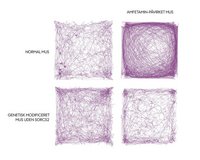- Education
-
Research
Current research
Talent
-
Collaboration
Businesses
Government agencies and institutions
Alumni
-
About AU
Organisation
Job at AU
New research from Aarhus University and one of the world's leading hospitals contributes to the understanding of ADHD. Experiments on mice show how the incorrect branching of nerve cells in the brain’s reward system leads to behavioural disorders.
2014.06.27 |

Through experiments on mice researchers has discovered an important mechanism in the brain that leads to ADHD.

The image maps the movements of a mouse in a closed space. The mouse lacks the receptor SorCS2 in its brain and is hyperactive compared to a normal mouse. It relaxes if it is given amphetamine (which resembles Ritalin) in contrast to normal mice, which become very active under the effects of the medicine.
The new research findings increase our understanding of why the neuropsychiatric disorder ADHD occurs in the brain. The research was made possible through a new collaboration between Aarhus University and the private American hospital The Mayo Clinic, and it can open the door for the development of more individual treatment.
According to the Danish ADHD association, between two and three percent of all Danish schoolchildren, plus a slightly lower number of adults, are diagnosed with ADHD. ADHD leads to attention disorders, hyperactivity and impulsivity. At the same time, ADHD also causes an increased risk of developing psychiatric disorders such as schizophrenia. Previous research has shown that the condition is connected with, among other things, a lowering of the brain’s ability to transport the transmitter substance dopamine – which is also known as the brain's reward substance. The new study has now discovered another important mechanism in the brain that leads to ADHD.
When nerve cells need to communicate in the brain, they do so with the help of projections that grow from one nerve cell to the other. Once the projection has reached its goal it receives a signal to stop growing. But apparently not in the case of ADHD patients. Using experiments on mice, the researchers could see that the projections were far too long because they continued to grow.
”We discovered that the mice lacked a specific receptor called SorCS2. The receptor is normally located on the cell’s surface where it acts as the cell's communication device. Without it the projection does not receive the signal telling it that it has reached its goal and it therefore continues to grow and to search for the nerve cell that it has to contact. This results in a large branching out of projections in the brain and leads to abnormal functions. When this happens in the brain's reward system – the dopaminergic system that we have studied – it causes these serious behavioural disorders. The mice in our experiments became hyperactive and had attention disorders, just as we find with ADHD patients. If we gave them a Ritalin-like substance, which is the most common ADHD medicines, then they became relaxed, which is unusual to see in mice,” says one of the researchers behind the study, Anders Nykjær, who is professor at Aarhus University and one of the driving forces behind the Danish flagship within neuroscience research, DANDRITE (The Danish Research Institute of Translational Neuroscience).
The lack of the receptor is the cause of certain types of ADHD that probably arise as a result of several different circumstances. The result shows that some types of ADHD are genetically determined by an abnormal function in the brain.
The research into SorCS2 has, however, also shown that the receptor may have an entirely different function. In the peripheral nervous system, which is the nervous system in the body that is located outside the brain and spinal cord, the receptor is cut into two. Here, it instead causes cell death by means of nerve damage.
When nerve damage occurs, for example, in the case of accidents which can lead to sensory disturbance, pain and paralysis, the nerve cells send the projections back to restore what has been damaged. This requires signals from support cells, but these are precisely the cells that SorCS2 kills off.
”It is very surprising that the same receptor can change form and function so that it speaks two completely different languages. At the same time, this is a very unfortunate function, as it prevents the nerve cells from repairing themselves,” says Associate Professor from Aarhus University, Simon Glerup, who has also participated in the study, before continuing:
”If we can find the ”scissors” and prevent the receptor from being cut in two, then maybe we can increase the possibility of the signal substances, which are important for the restoring of the nerve cells, being present. Nerve cell death is known from lesions and neurodegenerative diseases. In the long term, the new knowledge will contribute to making it possible to develop treatment for this type of condition.”
The research results have just been published in the world’s leading neuroscience journal Neuron.
Read the complete scientific article ”SorCS2 Regulates Dopaminergic Wiring and Is Processed into an Apoptotic Two-Chain Receptor in Peripheral Glia.”
Professor Anders Nykjær
Department of Biomedicine, Aarhus University
Direct tel.: +45 8716 7812
Mobile: +45 2899 2384
an@biokemi.au.dk